The prairies of Nebraska are home to many different prehistoric treasures, with some dating all the way back to the Paleozoic era when the state was submerged in a shallow sea. Throughout the ages, animals have come and gone, but their history remains recorded in the rocks all across Nebraska, giving us a rare glimpse into their ancient world. Let’s take a closer look at the dinosaurs that lived in Nebraska, and where you can see fossils today!
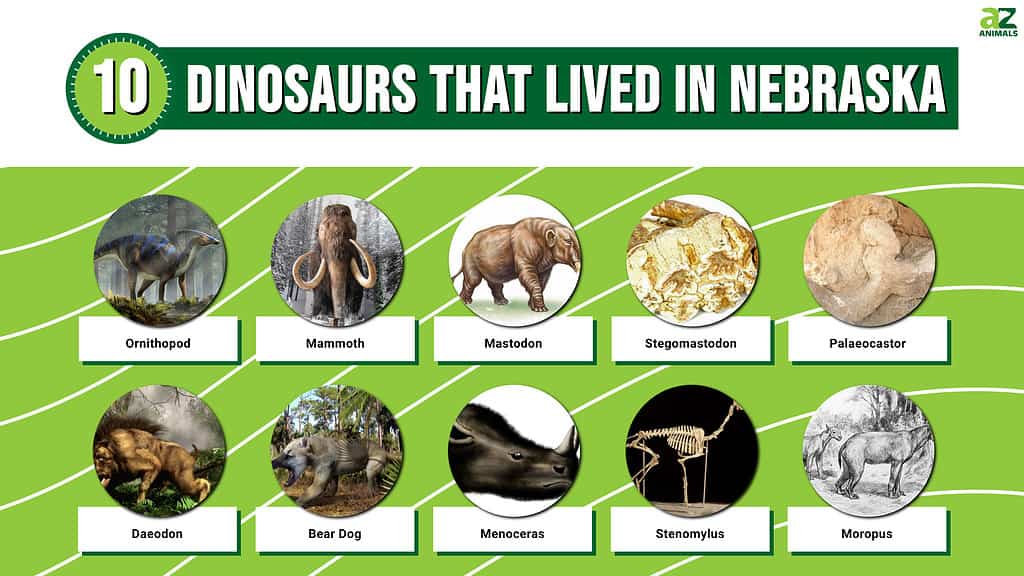
Ornithopod
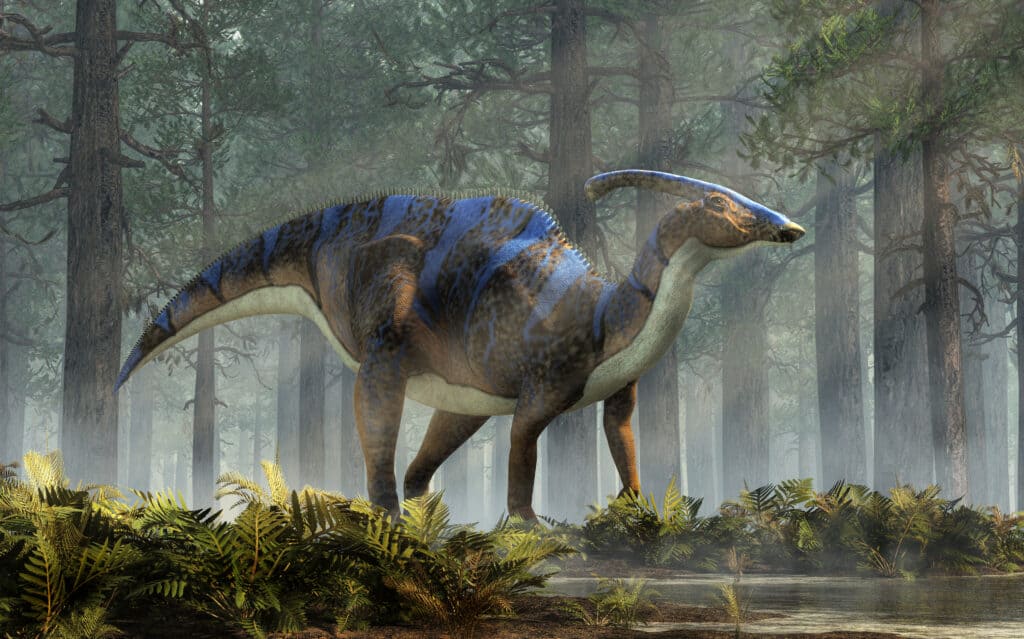
A total of
20 dinosaur footprints
were discovered here, each slightly bigger than dinner plates. The footprints were preserved in weathered sandstone from the Dakota Formation.
©Daniel Eskridge/Shutterstock.com
Although Nebraska is situated right next to other states filled with dinosaur fossils, there have not been any dinosaur fossils found here yet. However, in 2002 fossilized footprints were uncovered in Nebraska’s Jefferson County on a rocky outcrop. Over 66 million years ago, this area was the Western Interior Seaway. These tracks were made by a dinosaur that walked along its sandy shores.
A total of 20 dinosaur footprints were discovered here, each slightly bigger than dinner plates. The footprints were preserved in weathered sandstone from the Dakota Formation. It is likely that these tracks belonged to a tridactyl ornithopod, a group of medium-sized, plant-eating dinosaurs from the Cretaceous period. Ornithopods, or “bird feet” (from the Greek ornithos or “bird”, and pous or “feet”) had three-toed feet. They walked on their back legs and had long trails for balance. So far, these are the only actual dinosaur fossils documented in the state!
Other Fossils in Nebraska
Although the state is a bit short on dinosaur records, there are plenty of mammal fossils that have been found all across Nebraska. Here are just a few examples of other fossils in Nebraska:
Mammoth

Nebraska’s official state fossil is the mammoth.
©PradaBrown/Shutterstock.com
Nebraska’s official state fossil is the mammoth. This is fitting as three different types of mammoths have been discovered here: the Columbian mammoth (Mammuthus columbi), the imperial mammoth (Mammuthus imperator), and the woolly mammoth (Mammuthus primigenius). Mammoths were elephants of an impressive scale — much larger than the elephants we see today.
Nebraska is also home to the world’s largest Columbian mammoth fossil on display. Towering fifteen and a half feet tall, this incredible skeleton — nicknamed “Archie” — is on display at the University of Nebraska State Museum. A group of chickens feeding on a ranch in Lincoln County originally discovered Archie back in 1921.
Mastodon
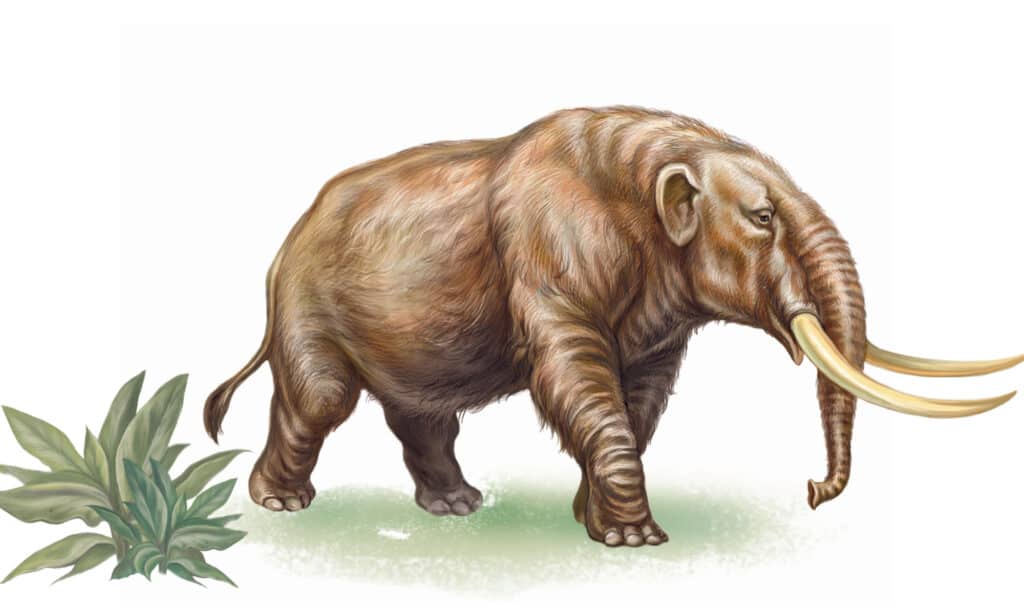
Mastodons were approximately the size of modern elephants.
©Liliya Butenko/Shutterstock.com
Mastodons roamed about Nebraska during the Ice Age. Adapted to the state’s cooler and drier climate, these shaggy giants found solace in the grasslands and fed on shrubs and pine trees. To this day, ancient remnants can still be found in the glacial deposits of Eastern Nebraska. In fact, just this year Travis Benda was on a deer hunting trip with his sons in Southeast Nebraska, and just happened to come upon the lower jaw of a mastodon frozen in the sand along the Little Nemaha River!
Stegomastodon
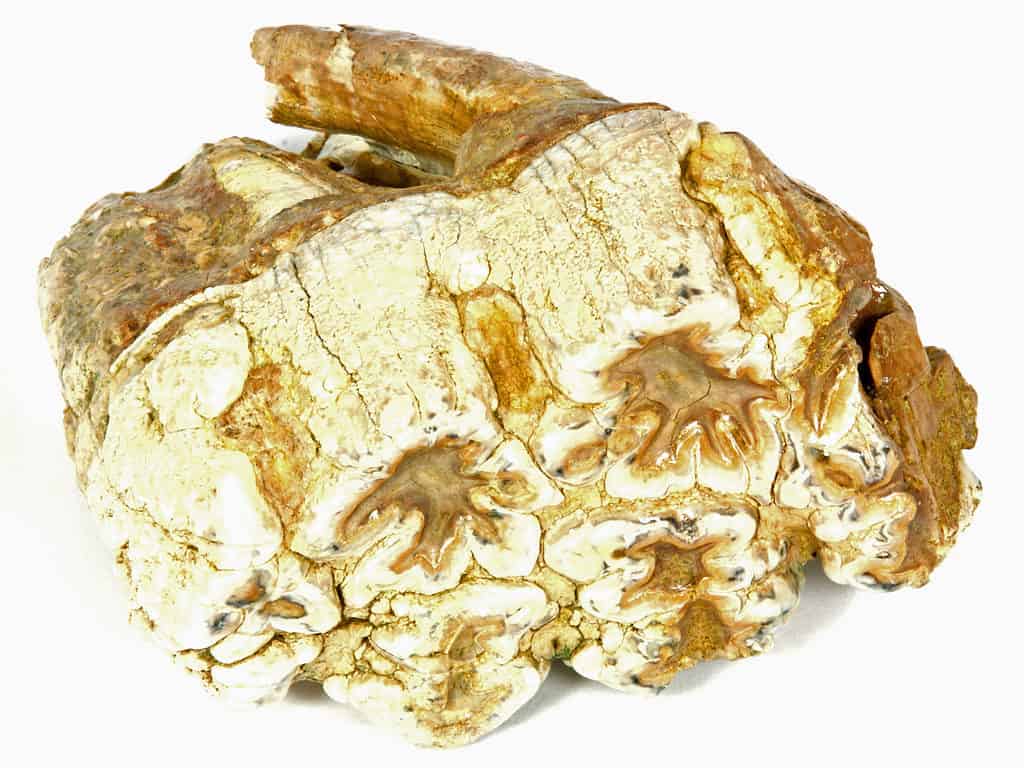
Another
type of elephant
fossil found in Nebraska is the stegomastodon. Seen here is a tooth found.
©Ryan M. Bolton/Shutterstock.com
Another type of elephant fossil found in Nebraska is the stegomastodon. This large animal definitely stood out from its more slender cousins. The stegomastodon had a very robust and distinctive profile, standing lower to the ground than mastodons. It was burly and had thick, upward-curving tusks that added an even stronger presence to its tank-like body.
Palaeocastor
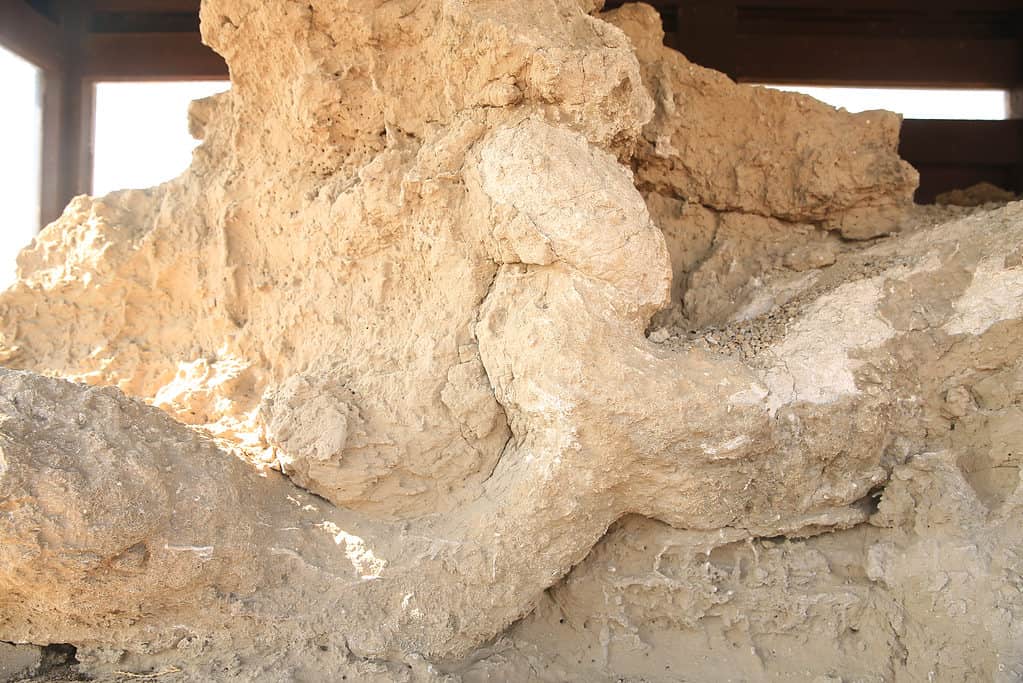
Nebraska’s palaeocastor was an animal like no other. This was a prehistoric beaver, but it didn’t build dams — instead, it buried into the ground!
©Traveller70/Shutterstock.com
Nebraska’s palaeocastor was an animal like no other. This was a prehistoric beaver, but it didn’t build dams — instead, it buried into the ground! It was armed with oversized front teeth and a strong desire to dig. The palaeocaster left behind winding trails underground that mystified scientists for many years. It earned the nickname “devil’s corkscrew” for this peculiar technique, and burrowed seven or eight feet into the ground.
Daeodon
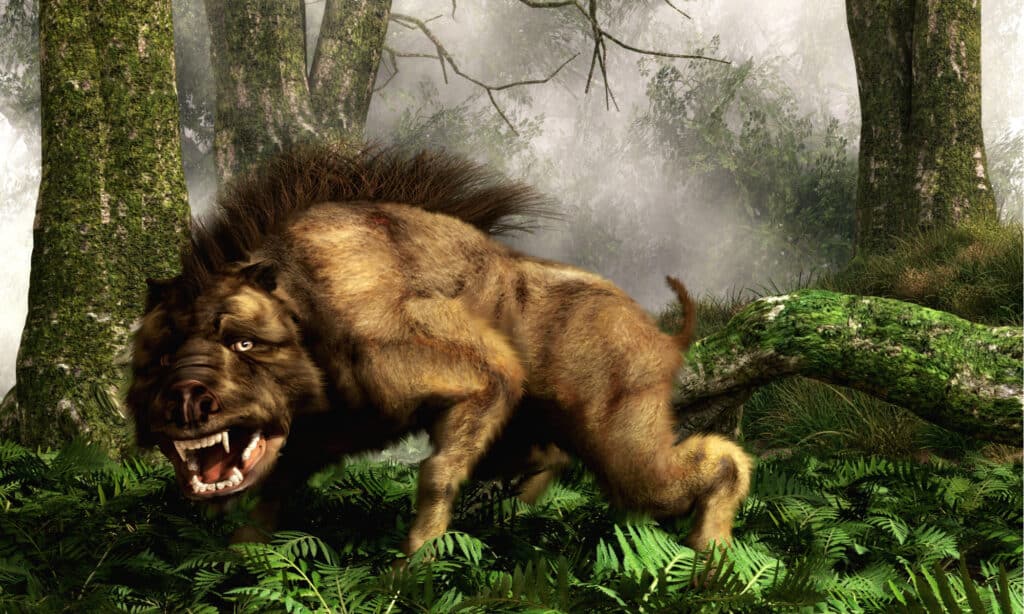
If you saw a
daeodon
during the Miocene Era, you might mistake it for a werewolfish-looking hippo rather than a pig.
©Daniel Eskridge/Shutterstock.com
If you saw a daeodon during the Miocene Era, you might mistake it for a werewolfish-looking hippo rather than a pig. This strange animal gets its name from the Greek words daios and odon, which mean “hostile” or “dreadful” and “teeth.” The largest of these great beasts was nearly 6 feet tall. It had a skull that measured about 3 feet long. The daeodon was an omnivore that lived on the prairies and grasslands in Nebraska.
Bear Dog
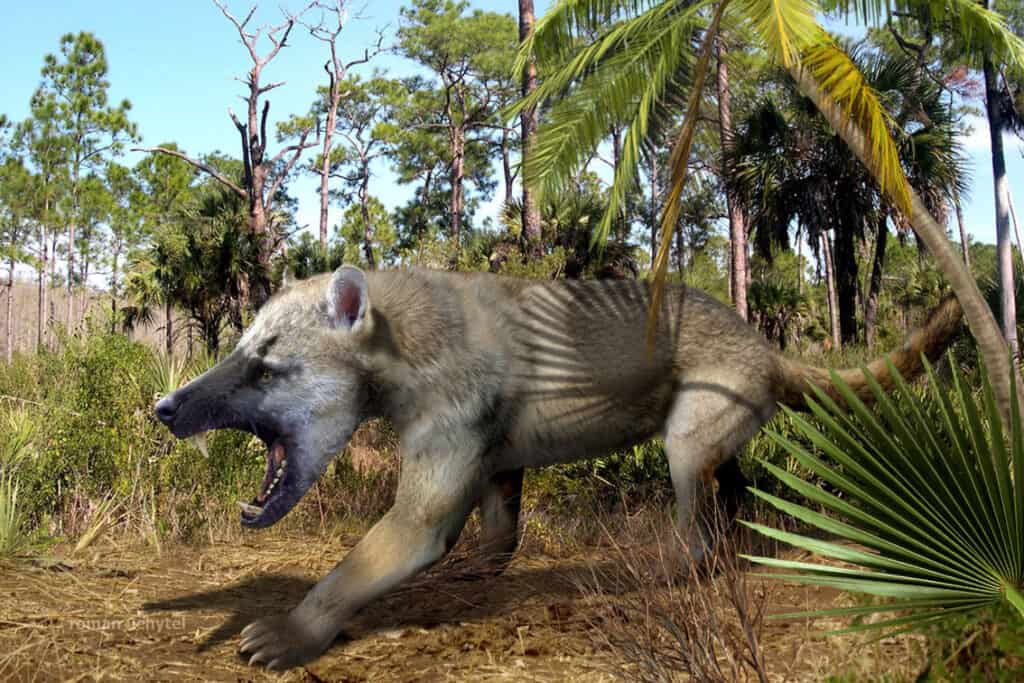
Not quite a bear, and not quite a dog, the “bear dog” or Amphicyon looked like a combination of both.
©Roman Uchytel / public domain – License
Not quite a bear, and not quite a dog, the “bear dog” or Amphicyon looked like a combination of both. In fact, Amphicyon, means “ambiguous dog,” as if scientists weren’t sure whether it was a dog or not! Fossils from bear dogs have been found in western Nebraska’s Runningwater Formation, as well as in the Sheep Creek Formation and the Olcott Formation of Sioux County. These large animals had heavy bodies with long snouts, and some could weigh far over 1,000 pounds!
Menoceras
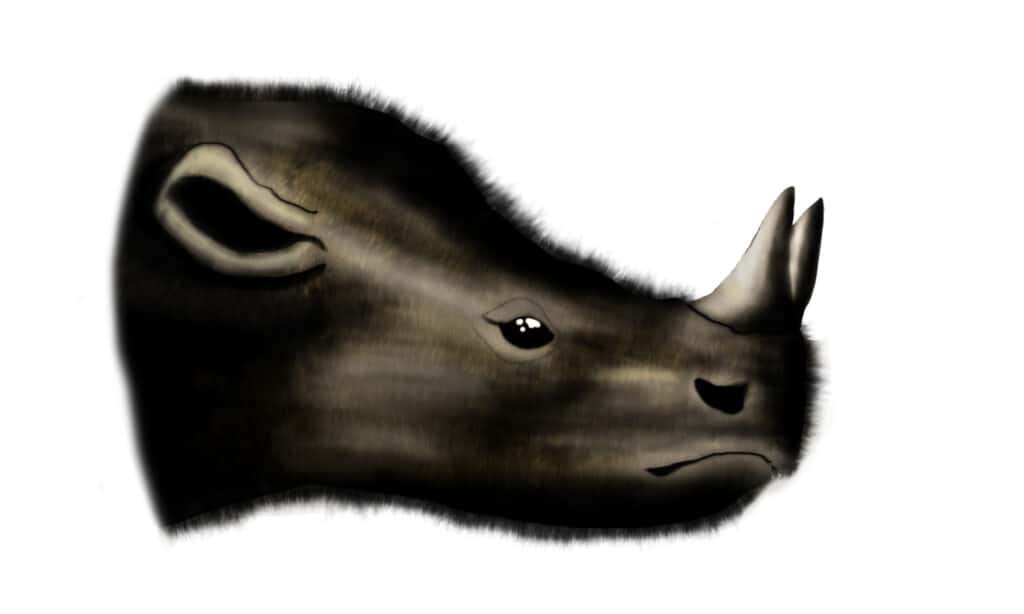
This ancient
rhinoceros
lived during the early Miocene era and grew around 5 feet long.
©Zero Smany/Shutterstock.com
This ancient rhinoceros lived during the early Miocene era and grew around 5 feet long. Males had two side-by-side horns on the tip of their noses, but females did not have any horns at all. Large numbers of fossilized remains of menoceras have been found at Agate Spring in Nebraska. This suggests that they likely lived in herds as they roamed across the open plains of North America.
Stenomylus
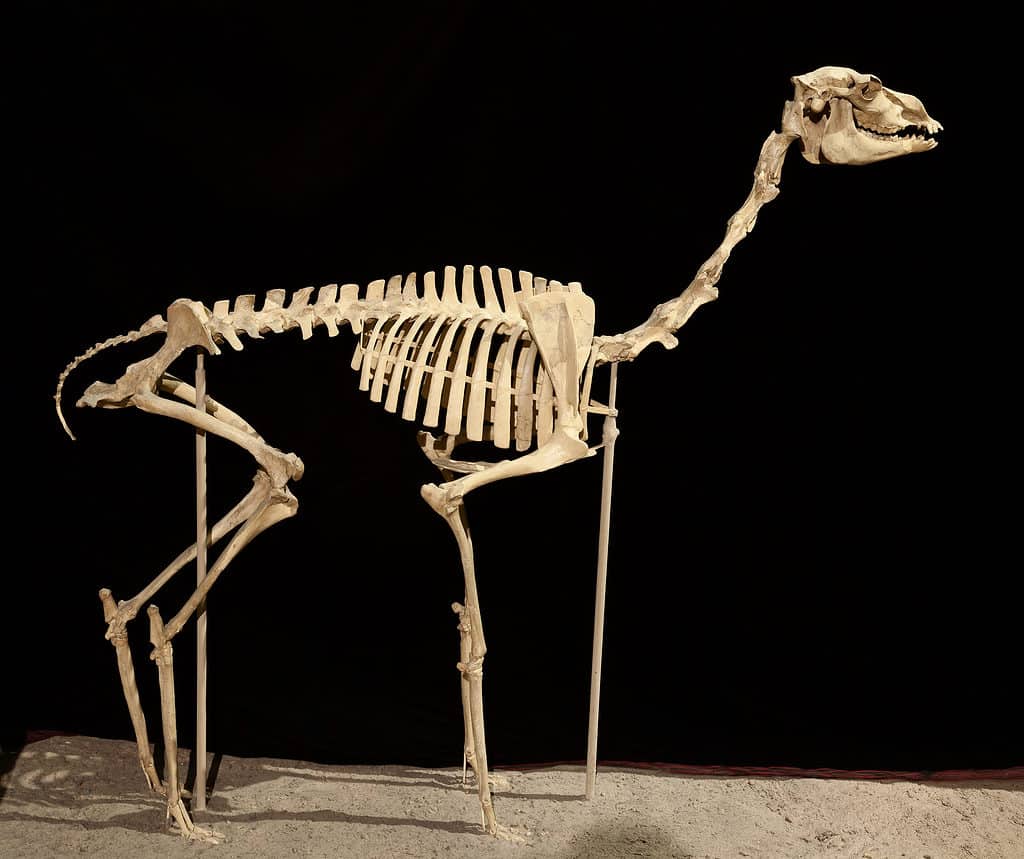
Stenomylus means “narrow grinding tooth,” and refers to the animals’ high-crowned teeth that they used to chew on grasses.
©HelloAdobe/Shutterstock.com
These gazelle-camels were about two feet tall at the shoulder. Stenomylus means “narrow grinding tooth,” and refers to the animals’ high-crowned teeth that they used to chew on grasses. Due to sudden and severe environmental changes, large numbers of stenomylus perished in Nebraska. Today, their intact skeletons suggest that this happened quickly enough that scavengers did not have time to get to them.
Moropus

Another strange and ancient animal that once lived in Nebraska is the moropus, a distant relative of the
modern horse
.
©2,206 × 1,639 pixels, file size: 1.11 MB, MIME type: image/jpeg – License
Another strange and ancient animal that once lived in Nebraska is the moropus, a distant relative of the modern horse. However, unlike today’s horses, these animals had claws instead of hooves. Because of this, scientists first named them “slow foot” because they thought they were some sort of large ground sloth! Moropus were around 7 to 8 feet tall with slim necks, short hind legs, and long front legs. They browsed and grazed shrubs and low-hanging trees. On occasion, they also used their massive claws to dig up tubers and roots to eat.
Where to See Fossils in Nebraska Today
While you’re unlikely to come upon many dinosaur fossils in Nebraska, the state is one of the best places around to see and learn about many prehistoric mammals. Let’s take a look at some of the places where you can see fossils in Nebraska today!
Agate Fossil Beds National Monument
This internationally recognized fossil site near Harrison, Nebraska, was once Captain James Cook’s cattle ranch. In 1892, however, a scientist from the University of Nebraska discovered the peculiar “Devil’s Corkscrews of Agate.” They later recognized this as the unique winding burrows dug by the palaeocastor (that awesome ground-dwelling beaver). Numerous well-preserved fossils from the Miocene era have since been unearthed from the Agate Fossil Beds. Many of these specimens can be seen in museums all around the world.
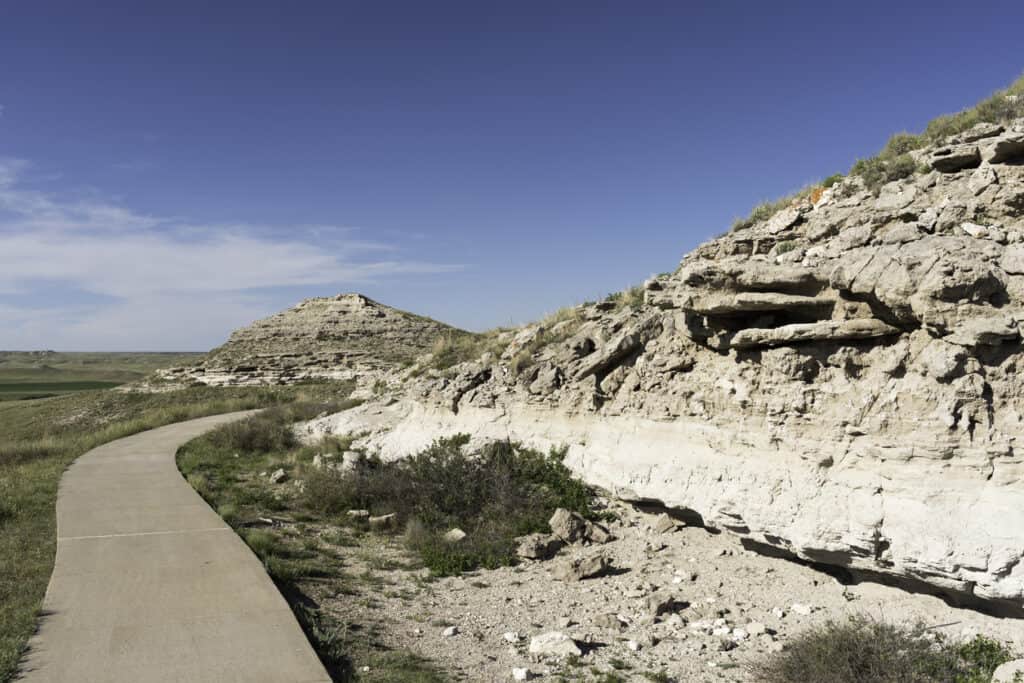
Agate Fossil Beds National Monument is located on the North Western Panhandle of Nebraska.
©iStock.com/RobertWaltman
Ashfall Fossil Beds State Historical Park
Around 12 million years ago, a large volcano in Idaho erupted and covered the Ashfall Fossil Beds in Nebraska with at least a foot of volcanic ash. Today, this “Pompeii” of prehistoric animals offers plenty to see and do for burgeoning paleontologists. It is still being excavated, so you can witness the process in real time and speak to actual paleontologists on site. Ashfall Fossil Beds State Historical Park is located in northeastern Nebraska’s Antelope County. It encompasses a 360-acre park with interpretive displays, paleontologists excavating on-site, a fossil preparation laboratory, and a visitor center.
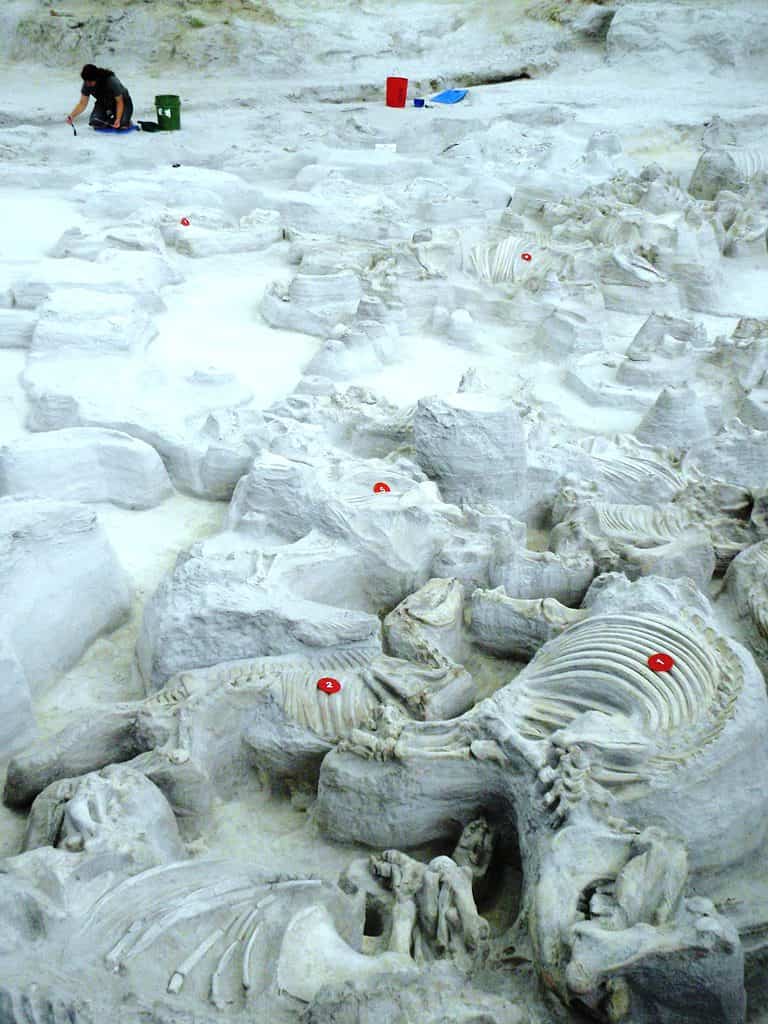
Around 12 million years ago, a large volcano in Idaho erupted and covered the Ashfall Fossil Beds in Nebraska with at least a foot of volcanic ash.
©2,448 × 3,264 pixels, file size: 1.69 MB, MIME type: image/jpeg – License
The University of Nebraska State Museum
For the best collection of elephant fossils in the world, head over to the University of Nebraska State Museum in Lincoln. There are more than one million fossil specimens here that have come from all over the state! And while you’re there, don’t forget to check out Archie, the museum’s gigantic mammoth fossil. The museum also offers a wonderful selection of activities, such as the Marx Science Discovery Center, the Mueller Planetarium, an engaging collection of paleontology exhibits and dinosaur galleries, captivating wildlife dioramas, gems and minerals from around the world, and exhibits on human culture and history.
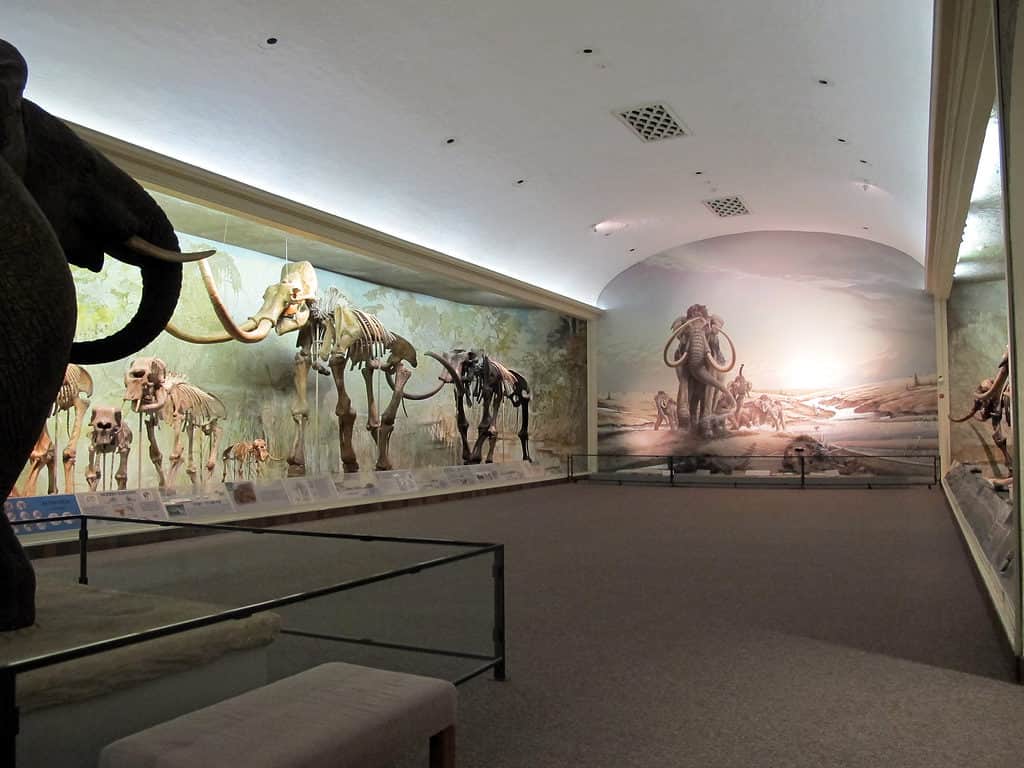
For the best collection of
elephant
fossils in the world, head over to the University of Nebraska State Museum in Lincoln.
©Hanyou23, CC BY-SA 4.0, via Wikimedia Commons – License
Toadstool Geologic Park
The unique sandstone rock formations of Toadstool Geologic Park make this region look like something you might find on the moon. Many of these giant sandstone blocks still have tracks made by ancient animals billions of years ago! This area was also covered by volcanic ash, preserving fossils from the region’s ancient flora and fauna. Some of the fossils preserved here include saber-toothed cats and ancient rhinoceroses, camels, three-toed horses, and large pig-like creatures, just to name a few. There is also a picnic and camping area at the park so you can enjoy your stay in the beauty of nature.

The unique sandstone rock formations of Toadstool Geologic Park make this region look like something you might find on the moon.
©Joseph Sohm/Shutterstock.com
Trailside Museum of Natural History
The Trailside Museum of Natural History in Crawford, Nebraska, has a very unique exhibit: a pair of gigantic mammoth skeletons that have been locked in a fatal duel for over 10,000 years! These two Columbian mammoths were battling for mating rights. However, as fate would have it, their tusks somehow locked together permanently, causing them to fall and perish where they stood. The intertwined mammoths were discovered less than 15 miles from where the museum stands today. The museum is also home to the fossils of many other prehistoric animals like three-toed horses, daeodons, ancient rhinos, and giant tortoises.

Part of the exposed bonebed – Hudson-Meng Bison Bonebed, northeast Nebraska in the Oglala National Grasslands
©This is an image of a place or building that is listed on the National Register of Historic Places in the United States of America. Its reference number is 73001076. – License
Hudson-Meng Bison Bonebed
Located in the Oglala National Grassland of Sioux County in Nebraska, the Hudson-Meng Bison Bonebed contains the fossils of around 600 bison that were all killed 10,000 years ago. The bison discovered here have not been seen in the United State for several centuries — they seem to be a transitional evolution between the extinct Bison antiques and its modern-day cousin, Bison bison. Originally, researchers thought this was a Paleoindian-age bison kill site. However, decades later researchers believed that the bison died from a natural event such as a grass fire. Current researchers are still probing the depths of this mysterious mass death in search of the truth of what caused it.
Opened to the public each summer from Memorial Day to Labor Day, visitors can view the climate-controlled enclosure built over the central portion of the bonebed. In addition, there are many interactive science activities, interpretive displays, and guided tours that offer insight into this perplexing discovery.
The photo featured at the top of this post is © iStock.com/Orla
Thank you for reading! Have some feedback for us? Contact the AZ Animals editorial team.






